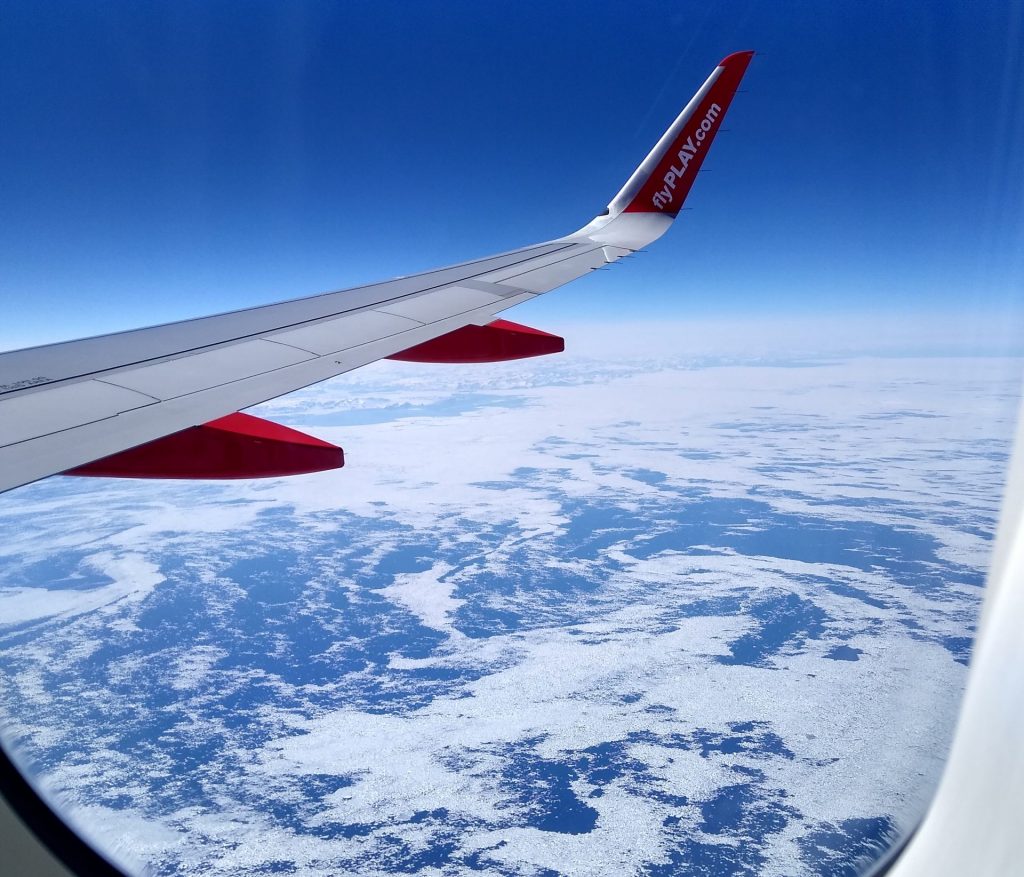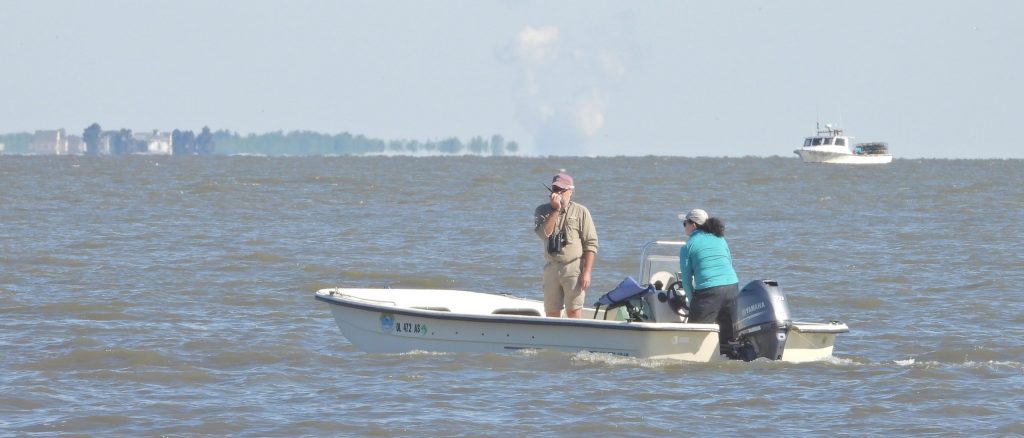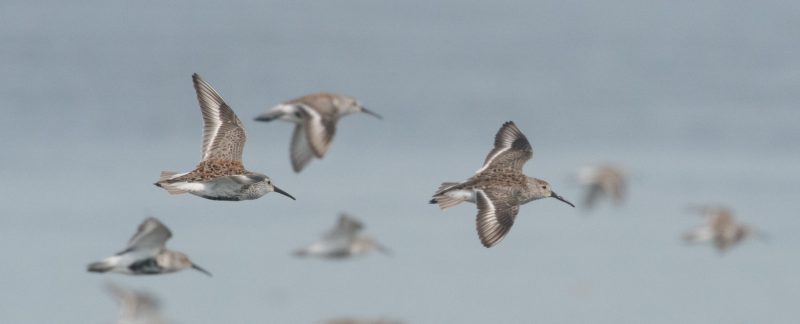So it’s three years since the WWRG team last came out to Delaware. Back then we bought our plane tickets and booked cars early as we were sure we would be coming over – then the World shut down… The only good thing was we got most of the costs of the flights and cars back. Into lockdown and virtually no fieldwork – it’s been a rough two years in many ways and we are still not out of the woods now – but we’re very grateful for vaccinations. This year we had to do supervised Covid tests and are living in a ‘bubble’ in a separate house – although we can use the basement of Penguin Manor to go and do data entry, but there is not too much of that yet.
We flew out with Play Air via Keflavik – no time to get outside to check waders for colour marks, sadly – but there are other Wash members doing so. We arrived in Baltimore, eventually got our hire cars and headed for Slaughter Beach (named after the Dutch family that founded it). With only one phone that we could get sat nav on at that point, we headed out with Richard in the lead, but it only took minutes to lose the second pick-up – we all made it eventually, but had to resort to map reading in the dark.

Jetlag day 1 – as always we woke up early, after not much sleep, to fog and variable amounts of rain. So we moved the furniture around in our house (photos were taken first, as we won’t have a clue what was where when we leave in three weeks time) so that we now have sitting and dining areas for 12. We have the usual tent city out back and a ‘portapotti’ this year, as there is only one bathroom in the house. Visits to the Nature Center in Mispillion Harbour and a short boat trip (which got our first resightings), led to a plan to catch Turnstone on Osprey Beach the next day – weather permitting. Two Common Loons (Great Northern Divers) were seen in the harbour and a late Harlequin Duck was a bonus record from Lighthouse Road. Saturday brought fog and rain and, after lots of deliberations and looking at different rainfall-radar sites, the catching was first postponed to later in the day and then pushed forward to Sunday. During site surveys, we found a potential Turnstone catch (there aren’t many Knot yet) at Cedar Creek and we decided that we would go there. The rest of the WWRG team arrived in the evening to be told they were getting up at 06:00 hrs to go catching!
On Sunday everybody made it up at 06:00 hrs and we managed a briefing and still left (almost) on time. We went up to Cedar Creek to set and got into position with three at the firing point, two twinklers either end and the rest behind the firing team. The catch developed nicely and got up to 60 Turnstone (and lots of Dunlin) with Nigel waiting for the last couple of birds, when they all took off. It still looked good though and we tried again, until Guy reckoned we had at least 60 in and we made the catch. Very successful:
| Species | Total |
| Semi-palmated Sandpiper | 55 |
| Sanderling | 13 |
| Dunlin | 175 |
| Turnstone | 86 |
| Total | 329 |
The Turnstone and Sanderling were flagged and all birds were processed and away in almost exactly three hours.
Monday was a big survey day, but few individuals of the target species (Knot, Turnstone, Sanderling) were found. A quick visit to the Nature Center was made by all the British teams and we were rewarded with sightings of the Harlequin Duck, a pod of dolphins over the breakwall and then a Wilson’s Petrel in a similar area – later we heard that some had been seen at the south end of Slaughter on the previous day. A violent storm was forecast for the afternoon and evening, so everyone retreated to the house, tents were taken down, and a rope slung over the ‘portapotti’ (we’ve seen what happens when they blow away). We saw some lightning and had some rain, but that was about it as the storm went out to sea. By 20:00 hrs it was clear nothing was going to hit us and the tent crew headed out to put the tents back up. There was an opportunity offered for two people to help band Piping Plovers the next day – with everyone wanting to do so, a lottery was set up and won by Katharine and Jean.
Tuesday brought better weather, although it was still windy and an attempt to put up a large awning at the house led to it being taken down again half-an-hour later! All the team headed out to count and resight except the Fowler’s team who used drop traps to catch and colour mark three breeding adult Piping Plover. Resightings were again rare but Richard and Rob found a good Sanderling option at Brockenbridge (~1,000), so some of the rest of the day was spent forming Sanderling flags and opening rings (some of them come closed and trying to open them on the beach leads to lots of bands being lost in the sand – a few did ping across the lounge floor, but they are not so hard to round up on laminate).

Wednesday was another early one as six people took the boat out with the gear and the rest walked in from the south (no road access). Two nets were quickly set, the firing team and base camp got into position and Rob was sent off in the boat (with a driver) to twinkle from the other side of the gut. We waited for the birds to turn up, and then watched the beach carefully for birds, and then waited for the birds to turn up and then waited some more for the birds to turn up. It was a lovely morning out on the beach, but there had been a better Horseshoe Crab spawn overnight and the birds had dispersed. We headed out again in the afternoon to count and resight, but there were still few target species to be found and very few of them had been marked. About 50 resights in the Harbour were lost when Nigel left his notebook on the bow of the boat when he went to mark out a possible catching area. The boat moved and so did the anchor rope, knocking the notebook into the sea never to be seen again…
Qoutes of the Day: generated by the WhatsApp group this year:
- Hen: “I would suggest wellie boats as was stick pretty mucky as of a few days ago”
- Richard: “Lots and lots on Dublin on back east”
- Nigel: “My sample has a lot of dinlin too”
- Graham: “Max of 40 tutu on point south”

